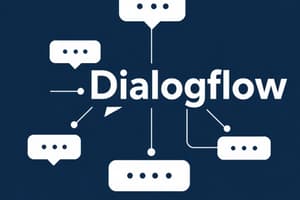Podcast
Questions and Answers
Why is version control and rollback capabilities crucial for chatbot systems in an enterprise environment?
Why is version control and rollback capabilities crucial for chatbot systems in an enterprise environment?
Ensures stability, allows for quick recovery from errors, and facilitates iterative improvements without risking system-wide failures.
Explain how a hybrid model in chatbot platforms combines the strengths of both rules/linguistic-based and AI/machine learning-based approaches.
Explain how a hybrid model in chatbot platforms combines the strengths of both rules/linguistic-based and AI/machine learning-based approaches.
It leverages human-crafted rules for known scenarios and machine learning for complex, nuanced interactions, providing robustness and adaptability.
What are the key data analytics considerations when choosing a chatbot platform, and how can these analytics be leveraged to enhance user engagement?
What are the key data analytics considerations when choosing a chatbot platform, and how can these analytics be leveraged to enhance user engagement?
Preferences and opinions revealed in conversations can be used as feedback to improve the chatbot's responses and tailor the experience.
What strategies can an organization employ to avoid vendor lock-in when implementing a chatbot solution, and why is this important?
What strategies can an organization employ to avoid vendor lock-in when implementing a chatbot solution, and why is this important?
How does prioritizing data security in chatbot development, particularly related to regulatory frameworks, affect the overall architecture and implementation of a chatbot system?
How does prioritizing data security in chatbot development, particularly related to regulatory frameworks, affect the overall architecture and implementation of a chatbot system?
What are the critical considerations when selecting a chatbot platform to ensure it aligns with an organization's needs for data management and analytics?
What are the critical considerations when selecting a chatbot platform to ensure it aligns with an organization's needs for data management and analytics?
Explain how conversational systems act as omni-channel enablers, and what benefits do they provide to organizations?
Explain how conversational systems act as omni-channel enablers, and what benefits do they provide to organizations?
What key considerations should guide the design of an HR chatbot to ensure it effectively facilitates corporate onboarding and provides a positive experience for new hires?
What key considerations should guide the design of an HR chatbot to ensure it effectively facilitates corporate onboarding and provides a positive experience for new hires?
How can metrics such as active users, number of issues resolved without human intervention, and customer satisfaction be leveraged to refine chatbot design and improve performance?
How can metrics such as active users, number of issues resolved without human intervention, and customer satisfaction be leveraged to refine chatbot design and improve performance?
What proactive steps can be taken to mitigate resistance to change when introducing chatbots in the workplace, and how can potential declines in employee productivity be addressed?
What proactive steps can be taken to mitigate resistance to change when introducing chatbots in the workplace, and how can potential declines in employee productivity be addressed?
How can a lack of a feedback loop policy lead to chatbot project failure, and what should be done to create and maintain an effective feedback loop?
How can a lack of a feedback loop policy lead to chatbot project failure, and what should be done to create and maintain an effective feedback loop?
What are some of the fundamental issues that contribute to the failure of chatbot projects as a whole?
What are some of the fundamental issues that contribute to the failure of chatbot projects as a whole?
What factors contributed to the retirement of IKEA's chatbot Anna, and what lessons can be learned to prevent similar failures in future chatbot implementations?
What factors contributed to the retirement of IKEA's chatbot Anna, and what lessons can be learned to prevent similar failures in future chatbot implementations?
Describe the roles of 'intent', 'entity', and 'context' in designing a conversational system
Describe the roles of 'intent', 'entity', and 'context' in designing a conversational system
Explain how system entities enhance the functionality and accuracy of a chatbot in understanding and responding to user inputs.
Explain how system entities enhance the functionality and accuracy of a chatbot in understanding and responding to user inputs.
What is the significance of defining slots in a chatbot design, and how do they improve the user experience during interactions?
What is the significance of defining slots in a chatbot design, and how do they improve the user experience during interactions?
Describe the role of contexts in managing conversational flow, and provide examples of scenarios where the use of expiry-based contexts is advantageous.
Describe the role of contexts in managing conversational flow, and provide examples of scenarios where the use of expiry-based contexts is advantageous.
Explain why follow-up intents are useful in complex conversational systems and provide examples of how they improve the user experience.
Explain why follow-up intents are useful in complex conversational systems and provide examples of how they improve the user experience.
Outline the purpose of a fallback intent and how it is used to enhance the robustness of a chatbot in handling unexpected or misunderstood user inputs.
Outline the purpose of a fallback intent and how it is used to enhance the robustness of a chatbot in handling unexpected or misunderstood user inputs.
Describe the function of a webhook in a chatbot system and provide examples of use cases where custom server-side logic is essential.
Describe the function of a webhook in a chatbot system and provide examples of use cases where custom server-side logic is essential.
Why is it important to create entities before creating intents?
Why is it important to create entities before creating intents?
Explain what an 'utterance' is in the context of conversational AI.
Explain what an 'utterance' is in the context of conversational AI.
Why is it important to give the chatbot more than one version of 'I do not understand'?
Why is it important to give the chatbot more than one version of 'I do not understand'?
In the example, 'send Alan a box of chocolates', what would the entities be?
In the example, 'send Alan a box of chocolates', what would the entities be?
Why is it important to have a human-like conversation with a chatbot?
Why is it important to have a human-like conversation with a chatbot?
Personalization is an important feature of chatbots. Explain how chatbots can provide personalized experiences.
Personalization is an important feature of chatbots. Explain how chatbots can provide personalized experiences.
What is the distinction between a rules/linguistic-based chatbot and AI/Machine learning-based chatbot? Which is preferred and why?
What is the distinction between a rules/linguistic-based chatbot and AI/Machine learning-based chatbot? Which is preferred and why?
Why is it important for chatbot platforms to support different forms of integration?
Why is it important for chatbot platforms to support different forms of integration?
What are some metrics to consider when attempting to build a functional chatbot?
What are some metrics to consider when attempting to build a functional chatbot?
How can the security of customer interactions compromise the chatbot database?
How can the security of customer interactions compromise the chatbot database?
Flashcards
Natural Language Processing (NLP)
Natural Language Processing (NLP)
A branch of AI that helps computers understand and interpret human languages.
Sentiment Analysis
Sentiment Analysis
Analyzing the emotional tone behind text.
Topic Modeling
Topic Modeling
Grouping texts by shared themes.
Text Categorization
Text Categorization
Signup and view all the flashcards
Text Clustering
Text Clustering
Signup and view all the flashcards
Information Extraction
Information Extraction
Signup and view all the flashcards
Relationship Extraction
Relationship Extraction
Signup and view all the flashcards
Named Entity Resolution
Named Entity Resolution
Signup and view all the flashcards
Human-like Conversation
Human-like Conversation
Signup and view all the flashcards
Personalization
Personalization
Signup and view all the flashcards
Version Control
Version Control
Signup and view all the flashcards
RULES/Linguistic-based Chatbot
RULES/Linguistic-based Chatbot
Signup and view all the flashcards
AI/Machine Learning-based Chatbot
AI/Machine Learning-based Chatbot
Signup and view all the flashcards
Hybrid Model Chatbot
Hybrid Model Chatbot
Signup and view all the flashcards
Data Analytics
Data Analytics
Signup and view all the flashcards
Vendor Lock-in Avoidance
Vendor Lock-in Avoidance
Signup and view all the flashcards
Security
Security
Signup and view all the flashcards
Shared Development
Shared Development
Signup and view all the flashcards
Platform Track-Record
Platform Track-Record
Signup and view all the flashcards
End-to-End Platform
End-to-End Platform
Signup and view all the flashcards
Integration Support
Integration Support
Signup and view all the flashcards
Natural Language Understanding (NLU)
Natural Language Understanding (NLU)
Signup and view all the flashcards
Data Management and Analytics
Data Management and Analytics
Signup and view all the flashcards
Onboarding Chatbot
Onboarding Chatbot
Signup and view all the flashcards
Intent
Intent
Signup and view all the flashcards
Entity
Entity
Signup and view all the flashcards
Slot Filling
Slot Filling
Signup and view all the flashcards
Context
Context
Signup and view all the flashcards
Chatbot Response
Chatbot Response
Signup and view all the flashcards
Webhook
Webhook
Signup and view all the flashcards
Study Notes
- Conversational systems involves building systems capable of engaging in conversations with humans.
- Natural Language Processing (NLP) is a field of AI that allows computers to understand and process human language.
- Key NLP features for building conversational systems include:
- Sentiment analysis.
- Topic modeling.
- Text categorization.
- Text clustering.
- Information extraction.
- Relationship extraction.
- Named entity resolution.
Rule-Based vs. AI Chatbots:
- Rule-based chatbots follow pre-defined paths and rules.
- AI chatbots use machine learning to understand user intent and generate responses.
Must-Have Chatbot Features:
- Human-like conversation that goes beyond answering questions to holding an intelligent conversation.
- Personalization where the bot brings in customer details and treats them individually.
- Version control for the chatbot system with rollback capabilities.
- Hybrid Model: Chatbot platforms are based on linguistic rules or AI/machine learning
- Linguistic rule-based chatbots require humans to create applicable rules and responses.
- AI/Machine learning-based chatbots needs data for curated training.
- Hybrid model allows for the best of both worlds.
- The data is a key consideration in choosing a platform.
- People reveal personal preferences, views, opinions, and feelings in everyday conversation.
- Feedback into the conversation can increase user engagement with the chatbot
- Vendor lock-in: Select chatbots that can run on a variety of platforms.
- Examining how much the build can be reused may save resources in the long term.
- Data Security is a key consideration of the chatbot, particularly when dealing with regulations and personal information.
- Flexibility is essential across multiple geographies and legal requirements.
- Shared development capabilities: The platform should allow for joint collaborative work.
- Track-record: Ensuring that the platform has a successful track record in your industry.
Selecting a Chatbot Platform involves:
- Choosing an end-to-end platform for design, building, testing, and hosting.
- Supporting different forms of integration.
- Providing NLU (Natural Language Understanding) features from the platform.
- Data Management & Analytics.
- Conversational Systems combined with Enterprise Systems, Integration, and Chatbots enable Omni-channel communication.
Onboarding Chatbot Use Case:
- A chatbot can facilitate corporate onboarding by allowing new hires to ask questions to the messenger interface.
- HR chatbot needs to be effective, reliable and enjoyable for the end user.
- The chatbot can be developed using platforms such as dialogFlow, Chatfuel, and Drift.
- Chatbot should be tested by new employees, while sourcing data from ERP and systems integration.
- Chatbots that offer a positive experience increase familiarity in the workplace.
Chatbot Metrics:
- Metrics to measure chatbot effectiveness include active users, issues resolved without human intervention, employee productivity, and customer satisfaction.
- Other metrics include cost reduction, error rate and response time.
Challenges in Implementing Chatbots:
- Employee resistance to change, with fears of job replacement.
- Management concerns about impact on employee productivity.
- Security of customer interactions in the chatbot database.
- Changes in customer responses when interacting with chatbots.
- Failure to address unique user needs.
- Lack of feedback integration for continuous improvement.
- Globalization requires multilingual support and cultural understanding.
Reasons for Chatbot Project Failures:
- Insufficient training data, therefore it is important to remember that more data produces better results.
- Poor conversations arising from single interface.
- The wrong chatbot platform.
- No/minimum integration.
- Inadequate data management.
- Security taken lightly.
IKEA's Anna Chatbot:
- The chatbot was retired after 10 years due to not delivering customer satisfaction it was created for.
- The issues arose from the chatbot not sounding not being able to answer direct questions properly.
Key Principles of Communication in Chatbots:
- Intent.
- Entity.
- Slot.
- Context.
- Response.
- Parameter.
- Utterance.
- Intent refers to what the users speak about or want to do and includes examples of each intent.
- Entities are when something is said.
- Types: System-S, Custom-C, Session-N.
- System Entities include date, time, number, unit currency, percentage, address, phone number, email, and color.
- Examples: dates/times, price/location, previous order.
- Dialog can be linear or non-linear.
- Linear dialogs deal with service, date, and time.
- Non-linear dialogs deal with real talk
- Entities can be later added to intents and can sometimes be required or not required.
- Slots filling is when the user does not provide required entities.
- Contexts are used in non-linear dialog, normally expiring in 20 minutes.
- Follow-up intent: Follows a specific intent.
- Fallback intent: Returns if users are confused.
- Fulfillment: Executes in the background.
- Response: Message to the user.
- Webhook: A server that provides service to the chatbot.
- Console.firebase.google.com is used to create a firebase database and link it to the chatbot.
- Parameters: Could be required or not required
- An utterance is anything someone says to the chatbot and may refer simply to the user input.
Utterances to "I DO NOT UNDERSTAND":
- Use 8-10 different ways of saying "I do not understand" such as:
- I did not catch that.
- My understanding of that is low.
To Wrap Things Up:
- Example Utterances:
- send something.
- send Alan a gift.
- send Alan a box of Chocolate.
Studying That Suits You
Use AI to generate personalized quizzes and flashcards to suit your learning preferences.




